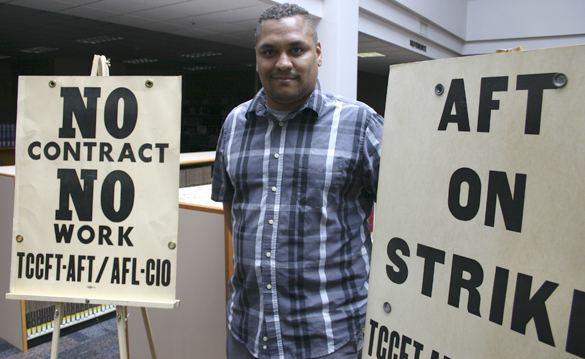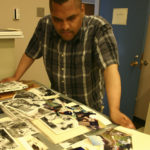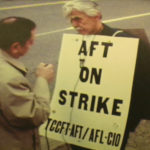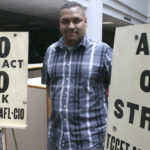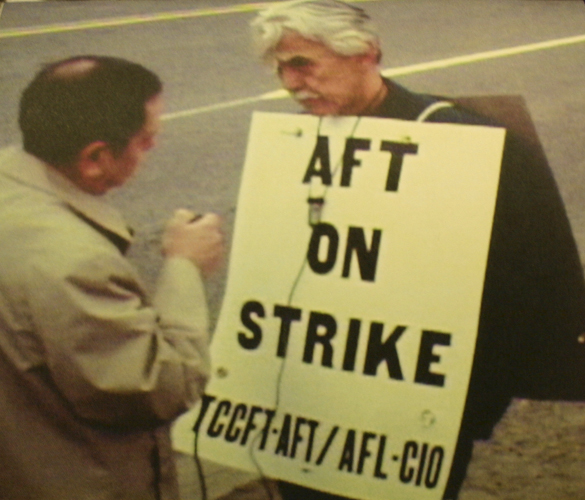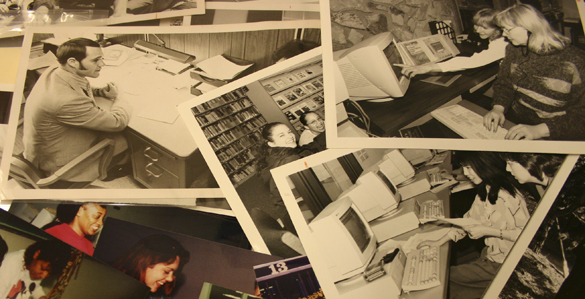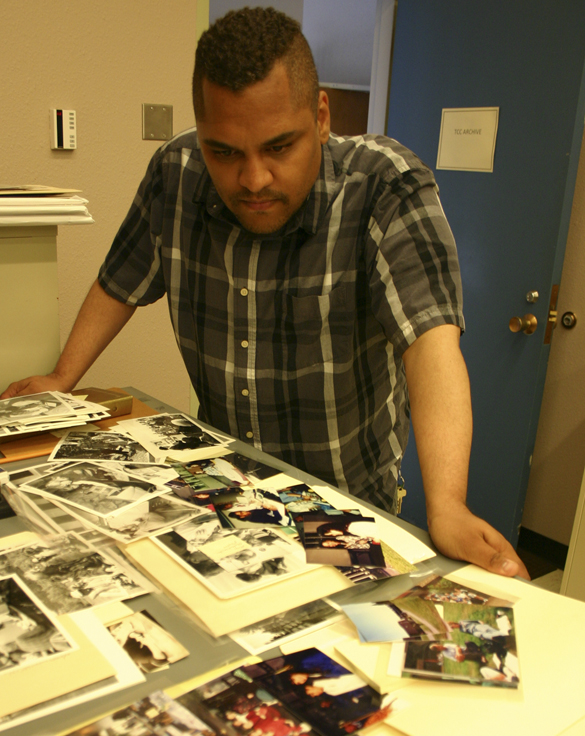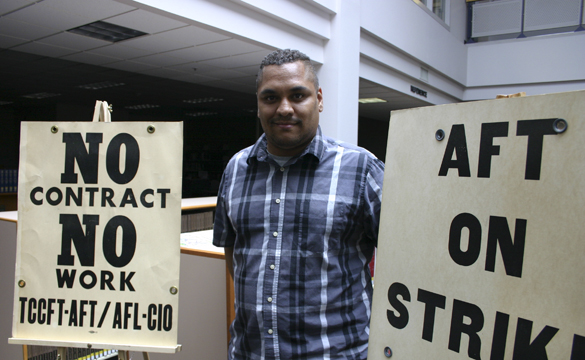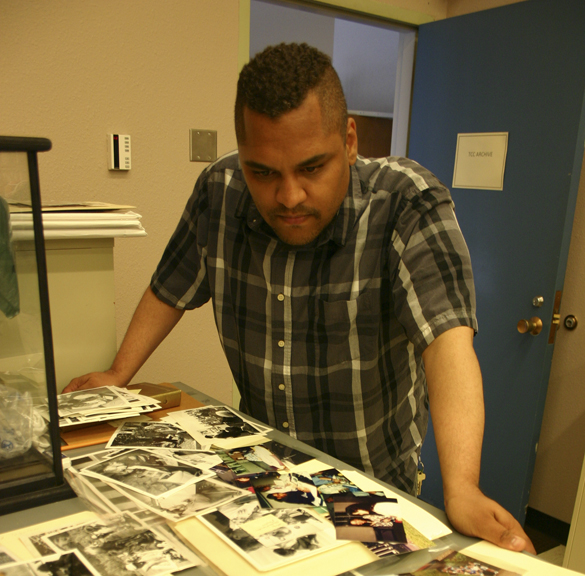A lot can happen in 50 years.
Just ask Dale Coleman.
For more than a year, the Tacoma Community College (TCC) Library Reference Specialist has researched old photographs, newspaper archives, press releases, oral histories, and board meeting minutes in preparation for the school’s 50th anniversary.
“It’s really tough because there are so many stories,” said Coleman during a recent interview in a windowless archive room deep inside the Pearl A. Wanamaker Library and Instructional Resource Center on campus. “The trick is sort of weaving a macro story. You’ll never be able to tell every story, but you kind of do your best to incorporate what was going on at the campus and what was going on in the world. Hopefully, I have accomplished that.”
Coleman’s history project traces back to a decision made two years ago to formally establish an archive on campus. A consultant was hired, an operating budget was created, and TCC eventually created a part-time position to manage the archive. TCC Library staff decided a narrative history would complement the archive as the school approached its 50th anniversary. As documents are added to the archive every week, Coleman leafs through the materials to produce what will eventually become a 125-page narrative history of the college. It will be available next year as an e-book with videos and other multimedia, as well as a print-on-demand version. TCC has already created a Web site to celebrate the 50th anniversary, and plans to launch the project in January by releasing excerpts online leading up to the official anniversary and celebration.
Coleman has completed the first draft, which is being reviewed by an advisory committee of current and former faculty, administration, and students.
“The heavy lifting, I like to think, is already complete,” said Coleman.
If you visit the campus today, it’s hard to believe just two buildings (and a handful of portables) constructed on a former 40-acre field of scotch broom in West Tacoma comprised TCC. Enrollment was just over 1,000 students when classes started on Sept. 27, 1965. Fifty years later, the campus sits on approximately 150 acres and serves approximately 14,000 students.
In the end, Coleman’s narrative history will cover the college’s lean years—a multi-year legislative battle during the early-1960s that allowed TCC’s creation; an influential African American student union (led by James L. Walton, who later became the first African American Tacoma city manager) that pushed for more diversity on campus; a faculty strike during the 1970s that saw teachers (including Murray Morgan, who was a TCC history professor at the time) waving picket signs outside the school’s entrance—as well as the arrival of President Pamela J. Transue, during the late-1990s, and more than $75 million in recent capital improvements that are visible today.
Coleman is well-placed to tell the story. He earned an Associate Degree from TCC in 2008, and a Bachelor’s Degree in Communications and Political Science from the University of Washington in 2011. He is enrolled at the University of Washington Information School, where he plans to earn a Master’s Degree in Library and Information Science.
The Tacoma Daily Index recently met with Coleman to discuss TCC’s 50th anniversary project. Our interview has been edited and condensed for publication.
ON THE FIGHT TO CREATE A COMMUNITY COLLEGE IN TACOMA
Community colleges became a thing after World War Two and the post-war era. The Truman Commission put out this report that said all of these GI’s are coming back from the war and there is a generalized need for more accessible education everywhere.
In Tacoma, obviously we have a major [military] base. We really could have benefited from that, but we didn’t for the longest time because we had this legislative caveat that said you couldn’t establish a community college in any county that already had a four-year institution. That’s just the way it was. We had Pacific Lutheran University and the University of Puget Sound, which were not affordable to Joe Schmo. The Tacoma School District superintendent at the time, Angelo Giaudrone, really became an advocate of community colleges in Washington State. Also, Pearl Wanamaker, who was the Washington State Superintendent at the time, really pressed for getting this law removed.
They were rejected the first time, in 1961, in favor of Big Bend Community College in Moses Lake, and Highline Community College [in Des Moines, Wash.]. For the next two years, there was this huge effort to bring the college here. After the bid was rejected, they started a committee and really tapped the community. They went to the union leaders. They went to the business community. They went to churches, Elks clubs, rotaries, the Parent Teacher Association, and the mayors of Fircrest and Tacoma, and they got them onboard.
[They received legislative approval] in 1963 to open a school in 1965. After that, they went to work constructing this place.
ON TCC’S EARLY YEARS
Before the college was established, it was a field of scotch broom. It was literally undeveloped land. This area was selected because it was a central location to serve the Tacoma area and the Gig Harbor area. The initial chunk of land was owned by Metro Parks Tacoma, and then they negotiated with the surrounding land owners in order to secure the space.
The college was approved on July 9, 1963. It opened on Sept. 13, 1965. Classes started on Sept. 27, 1965. Two permanent buildings. That was the college. You can sort of tell, as you walk around [campus], which buildings look like Flintstone houses. You can see which ones were the first buildings. If you read some of the old interviews, the architect had this whole philosophy of single-story buildings [so as not] to intimidate the students, and widely dispersed buildings to encourage communities of learning, as well as room for expansion.
They called it the ‘step-less’ college because Giaudrone was an early proponent of accessibility and mobilization, in terms of people with disabilities. In theory, this was a ‘step-less’ college. But in practice, there were big mud puddles. It was a wreck. We have some pictures that are pretty interesting. Frank Garrett, who started at the college in 1965, had some really great quotes in [TCC’s school newspaper] The Collegiate Challenge saying sometimes they say they designed these buildings with individuals with disabilities in mind, but they don’t actually spend enough time talking to the people [with disabilities]. Challenge [reporters] would dress in fishing clothes and fish in the mud puddles.
ON HOW THE NATIONAL BLACK STUDENT MOVEMENT IMPACTED TCC
The Obi Society, a black student union that had formed within weeks of the assassination of Dr. Martin Luther King, Jr., really felt like the college was lacking in terms of inclusiveness.
In May 1969, they famously marched on the president’s office with a list of eleven demands ranging from more African American instructors, more inclusive curriculum—just a variety of things where they thought the institution was lacking. There was an uproar. In fact, we tell the story—it’s sort of a college legend—of this rock on campus—it’s still there, it’s this big boulder—that was sort of the campus center. If you wanted to protest the Vietnam War or talk about civil rights or women’s rights, you would stand on that rock and students would naturally gather. The college never had a Red Square. It was never quite like the University of Washington. But even in our limited sort of environment, they made that sort of thing happen. This rock, the black students would paint it black. Overnight, they would come back and it would be painted white. It was sort of almost a hit you over the head metaphor for what was going on in the school. At one point, [former Obi Society President] Jim Walton tells the story about students trying to paint the rock white during the middle of the day. They had this confrontation and there was a crowd of students advancing on him. The Tacoma police were called and came in riot gear. It was really tense.
In terms of campus incidents, that was one where what was happening in the broader sphere penetrated the campus.
The college brought in a head of minority affairs, Carl Brown. The college had a hiring spree and brought in African American and Asian American instructors. Although it’s not directly linked to what they were doing during this time, during the weeks that this was going on, they brought on the first black member of the board of trustees.
It would be wrong to paint a caricature of an administration that was against progressiveness. They were moving very slowly. This group of students felt like they needed a little push. In retrospect, it seems like it was necessary because they did affect change.
Jim Walton talks about how he went on to become the first African American city manager in Tacoma. He tells a story about how through the experience of college, he learned that instead of trying to burn the system down, you can work from within the system and change it.
ON SOME OF THE NOTABLE PERSONALITIES WHO HAVE VISITED TCC
Fairly early on, the college started an artist and lecture series. Students established a really liberal policy of who could speak on campus. The more motivated student groups—and the Obi Society was definitely one of those—could bring anyone on campus. The motivated groups really went out there and they got people to come in and give some cool talks.
[Carl Brown] helped the Obi Society bring Muhammad Ali to campus. This was during his exile from boxing. He came to talk about politics, the Vietnam War. Muhammad Ali is probably number one for me, personally.
Also, and this is going to be a subjective list, but [jazz pianist] Dave Brubeck came. I’m a huge fan, so I thought that was pretty cool.
General [William] Westmoreland, who was commander of the allied forces in Vietnam, came and spoke. He famously said that he thought we won the war in Vietnam and we should prepare for a nuclear war with the Soviets.
ON HISTORIAN MURRAY MORGAN’S CONNECTION TO TCC
In the 1980s, TCC president Larry Stevens had problems connecting to the faculty, and there was a vote of no confidence at one point. It was rough for him because he was president during tremendous budget cuts. This was a period when he was expanding the college into satellite facilities—Gig Harbor, downtown Tacoma, North East Tacoma, Purdy at the women’s prison, McNeil Island—while budgets were being constrained. His strength was balancing budgets and assessing data. He created this tome of statistics like nothing the college had ever seen.
It turned out that we were investing too much money, according to his data, in the history program. So what he decided—I laugh because it was short-sighted and silly. Murray Morgan was teaching a class on Pacific Northwest history and it was super popular. Kids would wait quarters just to take his classes. [The college was] moving Murray Morgan’s class around. I think he was teaching out of a pub once. A church. A courthouse. Then Murray Morgan was told that they were cutting his course for budgetary reasons. They told him he could teach journalism classes. There were really awkward quotes in the newspaper where the president of the college says, “Well, he does have a degree in journalism from Columbia, but he doesn’t want to teach journalism classes.” Murray Morgan tells the newspaper, “Well, I’m pretty good at history.” So there was this big kerfuffle and he left.
In my opinion, it was a tragedy. People like him come around every so often. It was bad news. He was let go. The day after, [Murray Morgan] was nominated Washington State Teacher of the Year.
More information about the 50th Anniversary of Tacoma Community College is available online at tcc50.org.
Todd Matthews is editor of the Tacoma Daily Index and recipient of an award for Outstanding Achievement in Media from the Washington State Department of Archaeology and Historic Preservation for his work covering historic preservation in Tacoma and Pierce County. He has earned four awards from the Society of Professional Journalists, including first-place honors for his feature article about Seattle’s bike messengers; second-place honors for his feature article about whistle-blowers in Washington State; third-place honors for his feature article about the University of Washington’s Innocence Project; and third-place honors for his feature interview with Prison Legal News founder Paul Wright. His work has appeared in All About Jazz, City Arts Tacoma, Earshot Jazz, Homeland Security Today, Jazz Steps, Journal of the San Juans, Lynnwood-Mountlake Terrace Enterprise, Prison Legal News, Rain Taxi, Real Change, Seattle Business Monthly, Seattle magazine, Tablet, Washington CEO, Washington Law & Politics, and Washington Free Press. He is a graduate of the University of Washington and holds a bachelor’s degree in communications. His journalism is collected online at wahmee.com.
